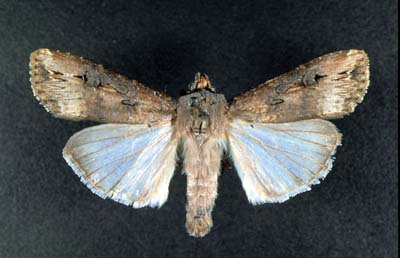
Black cutworm, Agrotis ipsilon, adult.
(Photographer: J. Capinera, University of Florida)
Vegetable crops that are commonly injured include artichoke, asparagus, bean, beet, broccoli, cabbage, cantaloupe, carrot, cauliflower, celery, corn, cowpea, cucumber, eggplant, garbanzo, garlic, kale, kohlrabi, lettuce, mustard, okra, onion, pea, pepper, potato, radish, spinach, squash, tomato, turnip, and watermelon. Weeds that serve as alternate hosts include bluegrass, curlydock, lambsquarters, and redroot pigweed. Damage occurs in the larval stage, and most of the feeding occurs at the soil surface. Some larvae may feed above ground. Larvae may cut several plants each night, and young plants are most vulnerable. Sampling techniques that are used to determine adult black cutworm populations include pheromone traps, light traps, and color traps. Larvae may be sampled using bait traps and are usually randomly distributed through the field. Cultural control practices include destruction of weed hosts, tillage, row covers, and proper plant nutrition. Persistent insecticides may be applied to plants and soil to provide suppression of black cutworm populations. Insecticide-treated baits may also be used to control larvae. Systemic insecticides may be applied to seeds to provide protection against larval injury.
Images
To save the Web-optimized images shown below to your hard drive:
|
Click to access Display and Print quality images. |
|
Click to access Display and Print quality images. |